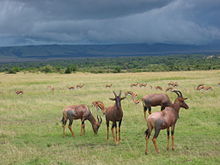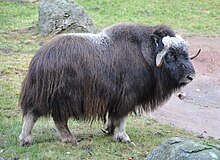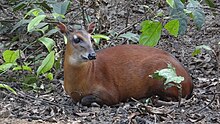Horn bearers
| Horn bearers | ||||||||||||
|---|---|---|---|---|---|---|---|---|---|---|---|---|
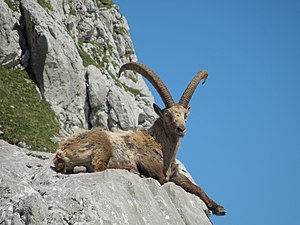
Alpine Ibex ( Capra ibex ) |
||||||||||||
| Systematics | ||||||||||||
|
||||||||||||
| Scientific name | ||||||||||||
| Bovidae | ||||||||||||
| Gray , 1821 |
The hornbeams (Bovidae) or cattle-like are a family of ruminants , which in turn are cloven-hoofed animals . They are currently the most diverse group of species and forms within the artifacts and ungulates and include cattle , sheep , goats and various forms of antelope . The family occurs naturally in both Eurasia and Africa and North America . Domesticated forms also reached Australia and South America . Hornbeams are very common in open landscapes, and many species also inhabit forests, wetlands and rocky landscapes. Depending on the type of landscape, different social systems have emerged, ranging from territorially solitary animals, often loyal to their location, to large, wandering herds. The reproduction is therefore dependent on the way of life of the individual species. There are monogamous pair formation as well as polygynous reproduction strategies. All in all, hornbeams feed on a variety of plants, from hard grass to soft leaves and fruits, occasionally animal remains are also eaten.
In general, two large groups of forms can be distinguished within the hornbeam. On the one hand there are cattle, buffalo and kudu, on the other hand goats, sheep, antelopes and gazelles. This dichotomy was already noticed at the beginning of the 20th century, but the history of research on the hornbeams as a uniform group goes back to the first half of the 19th century. In the past, the exact systematic structure of the group was the subject of numerous debates; only molecular genetic analysis methods, which emerged towards the end of the 20th century, gave a consistent picture. A revision of the family from 2011, which led to a doubling of the number of today's species, is not without controversy. This re-examination of the horn-bearers met with some rejection, but also found supporters who considered it necessary on several occasions. From a phylogenetic point of view, the hornbearers are relatively young. The oldest records date to the Lower Miocene , about 18 million years ago.
features
Habitus


A total of around 280 species belong to this family, ranging from the small ram ( Neotragus pygmaeus ) with a head-trunk length of around 40 cm and a weight of 2 kg to the giant bison ( Bos bison ) with a body length of 380 cm and a weight of 1000 kg is enough. The external characteristics of all species are the horns , of which there are almost always two in number (an exception is the four-horned antelope , among the domesticated forms the Jacob's sheep also has four horns) and their shape is specific to the species. As an extremely diverse group, the horned bearers have developed a relatively variable body structure that is adapted to the respective landscape conditions. Open land species tend to be larger than inhabitants of closed landscapes and also have larger and longer horns. A sexual dimorphism is developed in herd-forming species stronger than solitary. Open land animals also often have a longer body and long, narrow limbs with roughly the same developed front and rear legs, which is to be understood as an adaptation to rapid locomotion. In forest dwellers, the rear legs are generally stronger and the front legs are significantly shorter, which means that the croup is elevated. In addition, their bodies are usually shorter, which is due to the restricted space in forests. The color of the fur varies from a monotonous brown to individual spots and stripes, which often have a camouflaging character. The tail can be short and flat, but also long and round and have a tuft-like end. Throat sacs occur in many species, and some have a nasal mirror .
horns

The horns, the length of which varies from 2 cm in the small ram to over 1.50 m in the saber antelope ( Oryx dammah ) or the giant eland ( Taurotragus derbianus ), are only formed in some species in the males, but in most of them both Sexes, whereby those of the females are then often smaller and less strongly built. The causes for the development of the horns in female animals are not fully understood; it is assumed that they are defended against predators , food competition or a camouflage effect in intra-species competition to simulate a male animal. Since horned females are more likely to be found in large and conspicuous species of open land and less in forms hidden in the forest with camouflaging fur, according to some studies, protection from predators is seen as one of the driving factors. The horns are bony outgrowths of the skull that consist of cancellous substance or cavities on the inside and have a rough edge at the lower edge. They arise from an ossification center in the skin (os cornu) and grow from bottom to top, creating the typical pointed structure of the horns. In most species, the single horn is connected to the frontal bone via a short bone cone ( pedicle ) , exceptions are some representatives of the duiker ( Cephalophus ) as well as the four-horned antelope ( Tetracerus quadricornis ) and the Nilgau antelope ( Boselaphus tragocamelus ). The cone never reaches the dimensions of the bony horn, but always remains thinner than it. The horns are surrounded by a sheath made of horn ( keratin ), which is hollow on the inside (which among other things earned the horn bearers the old name "Cavicornia" ("hollow horns")). The coating starts at the lower edge of the bony horn and always protrudes above it, it grows from the inside out. In contrast to deer and fork-horned bearers , the forehead arms of the horn-bearers are never ramified, and the horns are neither shed annually, as is the case with the deer antlers , nor is the horn sheath subject to an annual renewal, as is the case with the fork- horns . Rather, they grow for a lifetime and do not regenerate when damaged or broken. Some of the horns are almost straight like those of the cliff jumpers ( Oreotragus ) or are curved like those of the wisent ( Bos bonasus ) or in a variety of ways twisted and curved. In some species they can be rotated clockwise ( homonymous or inverse ) or counter-clockwise ( heteronymous or normal ) (based on the right horn) . Such torsions occur on the one hand along the longitudinal axis of the horns, for example in the eland ( Taurotragus oryx ), without affecting their straight course, on the other hand they also occur in curved horns such as in the impala ( Aepyceros melampus ) or form open spirals, for example in the Cape great kudu ( Strepsiceros strepsiceros ). In any case, the turns are created by different growth rates in the horn sheaths.
Skeletal features


Further characteristic features can be found in the dentition and skeleton structure. The upper incisors , the upper canine and the first premolar in the upper and lower jaw are missing in the dentition . Only a few early forms, which are now extinct, still had a small upper canine, enlarged canine teeth, such as those found in some deer and musk deer , were never developed in horned bearers. The lower canine tooth resembles the incisors ( incisiform ). The standardized tooth formula of the hornbeams is: In some species, however, the second premolar is sometimes missing. In general, the premolars are molarized, so they resemble the posterior molars. These are characterized by a chewing surface pattern made of longitudinal, crescent-shaped ( selenodontic ) enamel ridges. They are also significantly higher-crowned ( hypsodont ) than deer. The row of teeth usually ends below the orbit . The frontal sinuses are strongly regressed in a larger part of the hornbeams. As is typical in the art of cloven-hoofed animals , the central axis of the hand and foot runs through rays III and IV. Both rays have grown together in the area of the metapodia and form the cannon leg . The inner and outer metapodia (rays II and V), i.e. bones attached to the side of the main ray (cannon bone ) of the metatarsus or the metacarpal , are more reduced in the horn-bearers than in the deer, as is the number of finger and toe phalanges mostly amounts to just one or two. The respective terminal phalanges still have hooves. All horn bearers therefore only have one pair of functional toes per foot (rays III and IV). Based on the structure of the feet, residents of closed and open habitats can be distinguished. The former have toes spread further apart, the individual toe phalanges are also arranged in a more or less linear row so that the foot is oriented closer to the ground. In the latter, the toes are close together, the middle phalanx is opposite the foremost phalanx at a steep angle and rises almost perpendicular to the ground. The feature is particularly extreme in the clip jumpers .
distribution

Horned bearers occur naturally in Eurasia and Africa as well as in North America , in South America there were never wild horned bearers, just as little in Australia. Domesticated species have been brought to almost all countries. The landscapes used by the hornbeams vary considerably depending on the demands of the species and are distributed from sea level to mountainous areas and highlands around 6000 m. Most hornbearers inhabit open terrain. The African savannahs offer numerous species an ideal habitat, although some representatives are also found in desert-like regions, more moderate steppes and grasslands, as well as forests. They occupied numerous ecological niches , which include tropical wetlands as well as rocky and stony habitats with steep slopes. Many species prefer undisturbed landscapes, others can also cope with areas that are more heavily influenced by humans.
Way of life
Territorial and social behavior


Various types of social organization have developed within the horn-bearers, which exist depending on the naturally given habitat. The following general forms can be distinguished:
- solitary and territorial animals such as dikdiks, klipspringers, and oribis; these mostly live in monogamous couples and mark their territories ; Both sexes are very similar, young animals leave the territory of the parent animals after sexual maturity and establish their own pairs and territories.
- solitary and non-territorial animals such as bushbucks; rather seldom in horn carriers; the action spaces of several individuals usually overlap, but there are often core areas without overlap that are used exclusively by individual animals; some males can also show territorial behavior.
- herding and territorial animals such as waterbuck, lychees, topis and some antelopes; the most common form of the social system among horn-bearers; the animals form roaming herds of females and juveniles, while males are generally territorial; young adult males separate from their group of origin and initially live in bachelor groups or with a female before setting up their own territories; in species with very extensive grazing areas and thus wide hiking trails, males only establish territories when they stay for longer periods of time.
- herding and non-territorial animals; very common in cattle and goatsies, but also in eland; Here the reproduction of the males takes place through dominance and not through territoriality, during the non-breeding period the sexes live separately.
As with many mammals, there is a positive relationship between body size and the size of the activity space. The Batesbock ( Neotragus batesi ) with a weight of around 2.5 kg has territories of 0.01 to 0.03 km², in the Uganda grass antelope ( Kobus thomasi ), which weighs up to 94 kg, the size of the territories is between 3 and 20 km². In addition, the size of the grazing areas depends on many natural factors. As a rule, the availability of food determines how extensive the activity space is and whether animals remain loyal to their place or migrate, with migrating animals predominantly forming herds. Such group formations can again be divided into two basic types. There are herds with contiguous or loosely scattered grazing areas; the respective use of the individual areas takes place in a more or less fixed order depending on the seasons. The herds of the Cape buffalo ( Syncerus caffer ), for example, have activity areas of 100 to sometimes more than 1000 km². In addition, there are nomadic associations with extremely large areas of activity, such as the Mongolian gazelle ( Procapra gutturosa ), who migrate over areas of up to 32,000 km². The action areas are hiked through in no fixed order, mostly in search of the best places to eat, which arise from individual precipitation events. A special phenomenon in herd-forming animals is the sometimes extremely large herd associations, such as the Serengeti white-bearded wildebeest ( Connochaetes mearnsi ) or the western Thomson's gazelles ( Eudorcas nasalis ), which can comprise thousands of animals and, for example, an annual migration of in the Serengeti to undertake more than 450 km.
nutrition
Foraging for food takes up a large part of daily activities. Small species such as dikdiks and curmuds tend to have frequent but very short feeding phases, while the large cattle tend to eat continuously for a longer period of time. In both cases, the total duration of the daily eating time is the same on average. In principle, horn-bearers are herbivores , but some species also occasionally eat birds , reptiles and amphibians . Three basic nutritional strategies are known within the horn-bearers:
- specialized and selective consumers of soft plant foods ( browser ) such as the dikdiks, duikers, bushbucks, klipspringers and kudu; they make up around 40% of the horn-bearers and mostly include smaller animals; very small species such as blue duiker specialize in protein-rich foods such as fruits , seeds and flowers and digest them comparatively quickly; larger representatives mainly eat leaves from trees and bushes; often parts of numerous plants are eaten, with some duckers between 50 and 80 species are known, with some kudu over 150, which are on the menu; water is absorbed through food.
- Grazers or consumers of coarse parts of plants ( grazer ); often larger, rarely very small representatives, which make up 25% of the hornbeams and mainly eat grass or fibrous plant parts; As a rule, they are inhabitants of open land, a distinction can also be made between animals that can be found in well-humid to swampy landscapes (buffalo, wildebeest, hartebeest) or in drylands (oryx antelopes); the animals are mostly water dependent.
- Consumers of mixed plant-based food ( mixed feeders ) with transitional forms for browsing and grazing , such as impalas, eland or numerous goats; they make up around 35% of the horn carriers; the animals are adaptable to different landscapes, the alternately hard or soft food components are eaten depending on the seasonal availability; water dependence often varies with the quality of the food.
The type of food eaten is also reflected in the physique. As a rule, browsers have a small and narrow mouth, while grazer have a significantly larger and wider one. "Schneider" and "Mahler" can be differentiated based on the teeth. "Cutters" have long, narrow molars with numerous sharp edges, the opposing teeth of the upper and lower jaw act like scissors and cut through the mostly soft plant food. “Mahler”, on the other hand, have broad molars with few elevations. They partly resemble those of horses and can grind the hard grass food well.
Reproduction

The mode of reproduction depends on the type of social organization. Small, territorial forest animals are often monogamous , pairing with territories that are being defended. Sex dimorphism is seldom developed in these . In larger and, above all, herd-forming animals, the males are often polygynous , which results in strong breeding competition among them and in a marked difference between male and female individuals. The mating season is generally all year round in the warmer regions, but strictly seasonal in the temperate climates. The sexual cycle lasts about 21 to 22 days in females, but it can last up to 26 days in extremely large species. The male mating competition, one of the most impressive in the animal world, is heavily ritualized and choreographed, but severe injuries can also occur. Depending on the shape of the horn, there are differently designed competitions, ranging from hooking and pushing with the horns for long-horned antelopes or stinging and piking for short-horned ones to pushing competitions for cattle to reciprocal head ramming for goat-like animals. In herds that wander through a defined area in an annual rhythm, males often have mating sites that are visited over several years. The gestation period varies between six and nine months, depending on the body size. Mostly only one young is born, but twin births have also been proven in ducks, goats and sheep. In general, the larger a species, the more often singular newborns are born. In almost all horn carriers, the pregnant female withdraws from her conspecifics for the birth and hides the newborn for a certain period of time.
Systematics
External system
| Internal systematics of the recent cetartiodactyla according to Zurano et al. 2019 | |||||||||||||||||||||||||||||||||||||||||||||||||||||||||||||||
|---|---|---|---|---|---|---|---|---|---|---|---|---|---|---|---|---|---|---|---|---|---|---|---|---|---|---|---|---|---|---|---|---|---|---|---|---|---|---|---|---|---|---|---|---|---|---|---|---|---|---|---|---|---|---|---|---|---|---|---|---|---|---|---|
|
The Hornträger are a family from the order of the cloven-hoofed animals (Artiodactyla). Within the artifacts they in turn form part of the subordination of the ruminants (Ruminantia), whose members have a multi-chambered stomach , and the subordinate taxon of the forehead weapon bearers (Pecora), whose special feature is the formation of horns and antlers. As a result, the horn-carriers are more closely related to the deer (Cervidae), the giraffe-like (Giraffidae), the musk deer ( Moschidae) and the fork-horn carriers (Antilocapridae). Of all these groups, the horn-bearers represent by far the most extensive family. Originally the pronghorn ( Antilocapra ) was regarded as closely related to the horn-bearers (and partly managed within them), but molecular genetic studies refer it to the basis of the development of the forehead weapon bearers. According to this, the horn-bearers form a community group with the deer and the musk deer, the latter occasionally also being placed in a common superfamily with the horn-bearers (Bovioidea). The splitting off of the horn bearers from the other forehead weapon bearers occurred in the transition from the Oligocene to the Miocene around 24 million years ago.
Internal system
Already at the beginning of the 20th century, a dichotomy of the horn carriers was recognized on a morphological basis , whereupon a division into the Boodontia (cattle, buffalo and kudu) and the Aegodontia (sheep, goats, gazelles and antelopes) took place. This dichotomy has also been confirmed by modern molecular genetic studies. Today the hornbeams are divided into two subfamilies, the Bovinae (= Boodontia) and the Antilopinae (= Aegodontia). The Bovinae are characterized above all by their medium-sized to very large and above all heavy physique, their limbs have strong muscles. They have slightly to more curved horns, which often have a quill on the front and never have transverse ring structures as in the Antilopinae. Bovines prefer landscapes with dense undergrowth or forests. The Antilopinae represent a very diverse group with small and large forms. In contrast to the bovines, the fur color is more varied with raised stripes on the sides of the body or on the face. Except for a few mountain forms, the relatives are rather lightly built and often represent open-land residents. While the Bovinae have long been considered an independent subfamily, the Antilopinae were originally divided into several equal groups. Within the hornbeams, around a dozen shoots can be distinguished, nine of which belong to the Antilopinae alone.
Overview of the genera and species of the hornbeam
| Internal systematics of the Bovidae
according to Zurano et al. 2019 |
|||||||||
|---|---|---|---|---|---|---|---|---|---|
|
| Internal systematics of the Bovinae according to Zurano et al. 2019 | |||||||||||||||||||||||||||||||||||||||||||||||||||||||||||||||
|---|---|---|---|---|---|---|---|---|---|---|---|---|---|---|---|---|---|---|---|---|---|---|---|---|---|---|---|---|---|---|---|---|---|---|---|---|---|---|---|---|---|---|---|---|---|---|---|---|---|---|---|---|---|---|---|---|---|---|---|---|---|---|---|
|
|
Internal systematics of the Antilopinae according to Zurano et al. 2019 |
|||||||||||||||||||||||||||||||||||||||||||||||||||||||||||||||||||||||||||||||||||||||||||||||||||||||||||||||||||||||||||||||||||||||||||||||||||||||||||||||||||||||||||||||||||||||||||||||||||||||||||||||||||||||||||||||||||||||||||||||||||||||||||||||
|---|---|---|---|---|---|---|---|---|---|---|---|---|---|---|---|---|---|---|---|---|---|---|---|---|---|---|---|---|---|---|---|---|---|---|---|---|---|---|---|---|---|---|---|---|---|---|---|---|---|---|---|---|---|---|---|---|---|---|---|---|---|---|---|---|---|---|---|---|---|---|---|---|---|---|---|---|---|---|---|---|---|---|---|---|---|---|---|---|---|---|---|---|---|---|---|---|---|---|---|---|---|---|---|---|---|---|---|---|---|---|---|---|---|---|---|---|---|---|---|---|---|---|---|---|---|---|---|---|---|---|---|---|---|---|---|---|---|---|---|---|---|---|---|---|---|---|---|---|---|---|---|---|---|---|---|---|---|---|---|---|---|---|---|---|---|---|---|---|---|---|---|---|---|---|---|---|---|---|---|---|---|---|---|---|---|---|---|---|---|---|---|---|---|---|---|---|---|---|---|---|---|---|---|---|---|---|---|---|---|---|---|---|---|---|---|---|---|---|---|---|---|---|---|---|---|---|---|---|---|---|---|---|---|---|---|---|---|---|---|---|---|---|---|---|---|---|---|---|---|---|---|---|---|---|---|
|
The system presented here essentially follows Groves and Leslie 2011 or Groves and Grubb, but also takes into account more recent findings:
- Family Bovidae Gray , 1821
-
- Subfamily Bovinae Gray , 1821 (" forest goats " and cattle )
-
- Tribus Bovini Gray , 1821 ( cattle )
-
- Genus Actual Cattle ( Bos Linnaeus , 1758)
- American bison ( Bos bison Linnaeus , 1758; also bison bison )
- Wisent ( Bos bonasus Linnaeus , 1758; also Bison bonasus )
- † Bergwisent ( Bos caucasicus Satunin , 1904; also Bison caucasicus )
- Gaur ( Bos gaurus C. H. Smith , 1827); from this species the Gayal ( Bos frontalis ) was domesticated
- Banteng ( Bos javanicus d'Alton , 1823); the Balirind was domesticated from this species
- Yak ( Bos mutus Przewalski , 1883); from this species the domestic animal form Bos grunniens was domesticated
- † Aurochs ( Bos primigenius Bojanus , 1827); from this species the domestic cattle ( Bos taurus ) and the zebu ( Bos indicus ) were domesticated
- Kouprey ( Bos sauveli Urbain , 1937)
- Genus Asiatic Buffalo ( Bubalus C. H. Smith , 1827)
- Water buffalo or arni ( Bubalus arnee ( Kerr , 1792)); from this species the pet form Bubalus bubalis was domesticated
- Lowland anoa or anoa ( Bubalus depressicornis ( CH Smith , 1827))
- Tamarau or Mindoro Buffalo ( Bubalus mindorensis Heude , 1888)
- Mountain anoa ( Bubalus quarlesi ( Ouwens , 1910)); the species is not generally recognized and is usually listed together with the lowland anoa
- Genus Syncerus Hodgson , 1847
- Sudan buffalo ( Syncerus brachyceros ( Gray , 1837))
- Cape buffalo ( Syncerus caffer ( Sparrman , 1779))
- Virunga buffalo ( Syncerus matthewsi ( Lydekker , 1904))
- Red buffalo ( Syncerus nanus ( Boddaert , 1785))
- Genus Pseudoryx Dung, Giao, Chinh, Tuoc, Arctander & MacKinnon , 1993
- Saola or Vietnamese forest cattle ( Pseudoryx nghetinhensis Dung, Giao, Chinh, Tuoc, Arctander & MacKinnon , 1993)
- Tribus Boselaphini Knottnerus-Meyer , 1907
-
- Genus Tetracerus Geoffroy Saint Hilaire & F. Cuvier , 1824
- Four-horned antelope ( Tetracerus quadricornis ( de Blainville , 1816))
- Genus Boselaphus de Blainville , 1816
- Nilgau antelope ( Boselaphus tragocamelus ( Pallas , 1766))
- Tribus Tragelaphini Jerdon , 1874
-
- Genus Nyala Heller , 1912
- Nyala or lowland nyala ( Nyala angasii ( Angas , 1849))
- Genus Tragelaphus de Blainville , 1816
- Sudan schirrantilope ( Tragelaphus bor Heuglin , 1877)
- Mountain nyala ( Tragelaphus buxtoni ( Lydekker , 1910))
- Ethiopian schirrantilope ( Tragelaphus decula ( Rüppell , 1835))
- Bongo ( Tragelaphus eurycerus ( Ogilby , 1837))
- East coast schirrantilope ( Tragelaphus fasciatus Pocock , 1900)
- Western sitatunga ( Tragelaphus gratus Sclater , 1880)
- Nile sitatunga ( Tragelaphus larkenii ( St. Leger , 1931))
- Highland schirrantilope ( Tragelaphus meneliki Neumann , 1902)
- Zambia schirrantilope ( Tragelaphus ornatus Pocock , 1900)
- Congo schirrantilope ( Tragelaphus phaleratus ( CH Smith , 1827))
- Senegal schirrantilope ( Tragelaphus scriptus Pallas , 1766)
- Zambezi sitatunga ( Tragelaphus selousi Rothschild , 1898)
-
Sitatunga or Wasserkudu and East Africa Sitatunga ( Tragelaphus spekii Speke , 1863)
 Sitatunga ( Tragelaphus spekii )
Sitatunga ( Tragelaphus spekii ) - Southern schirrantilope ( Tragelaphus sylvaticus ( Sarrman , 1780))
- Nicose Situnga ( Tragelaphus sylvestris ( Meinertzhagen , 1916))
- Genus Ammelaphus Heller , 1912
- Southern Kleinkudu ( Ammelaphus australis Heller , 1913)
- Lesser kudu or northern kudu ( Ammelaphus imberbis ( Blyth , 1869))
- Genus Strepsiceros C. H. Smith , 1827
- Northern great kudu ( Strepsiceros chora ( Cretzschmar , 1826))
- Western great kudu ( Strepsiceros cottoni Dollman & Burlace , 1928)
- Cape great kudu ( Strepsiceros strepsiceros ( Pallas , 1766))
-
Zambezi great kudu ( Strepsiceros zambesiensis Lorentz , 1894)
 Zambezi greater kudu ( Strepsiceros zambesiensis )
Zambezi greater kudu ( Strepsiceros zambesiensis )
- Genus eland ( Taurotragus Wagner , 1855)
- Giant eland ( Taurotragus derbianus ( Gray , 1847))
- Eland ( Taurotragus oryx ( Pallas , 1766))
- Subfamily Antilopinae Gray , 1821
-
-
- Genus goat ( Nesotragus von Düben , 1846)
- Batesbucks ( Nesotragus batesi ( De Winton , 1903))
- Kirchenpauer muskbuck ( Nesotragus kirchenpaueri Pagenstecher , 1885)
- Livingstone muskbuck ( Nesotragus livingstonianus Kirk , 1865)
- Musk rams ( Nesotragus moschatus von Düben , 1846)
- Tribe Neotragini Sclater & Thomas , 1894
-
- Genus Neotragus C. H. Smith , 1827
- Small ram ( Neotragus pygmaeus ( Linnaeus , 1758))
- Tribe Aepycerotini Gray , 1872
-
- Genus Impalas ( Aepyceros Sundevall , 1847)
- Black heel antelope or impala ( Aepyceros melampus ( Lichtenstein , 1812))
-
Black-nosed Impala ( Aepyceros petersi Bocage , 1879)
 Black-nosed Impala ( Aepyceros petersi )
Black-nosed Impala ( Aepyceros petersi )
- Tribus Antilopini Gray , 1821 ( Gazelle-like )
-
- Genus Raphicerus C. H. Smith , 1827
- Ibex ( Raphicerus campestris ( Thunberg , 1811))
- Natal Greisbock ( Raphicerus colonicus Thomas & Schwann , 1906)
- Cape Goshawk ( Raphicerus melanotis ( Thunberg , 1811))
- Sharpe's ram or northern ram ( Raphicerus sharpei Thomas , 1897)
- Genus springbok ( Antidorcas Sundevall , 1847)
- Angola springbok ( Antidorcas angolensis Blaine , 1922)
- Kalahari springbok ( Antidorcas hofmeyri Thomas , 1926)
- Cape springbok or springbok ( Antidorcas marsupialis ( Zimmermann , 1780))
- Genus Ammodorcas Thomas , 1891
- Dibatag or Dibetag ( Ammodorcas clarkei ( Thomas , 1891))
- Genus giraffe gazelles ( Litocranius Kohl , 1886)
- Northern giraffe gazelle ( Litocranius sclateri Neumann , 1899)
-
Southern giraffe gazelle ( Litocranius walleri ( Brooke , 1878))
 Southern giraffe gazelle ( Litocranius walleri )
Southern giraffe gazelle ( Litocranius walleri )
- Genus Saigas ( Saiga Gray , 1843)
- Mongolian Saiga ( Saiga mongolica Bannikov , 1946; also Saiga borealis )
- Saiga ( Saiga tatarica ( Linnaeus , 1766))
- Genus Antelope Pallas , 1766
- Deer goat antelope ( Antilope cervicapra ( Linnaeus , 1758))
- Genus Nanger Lataste , 1885
- Damagazelle ( Nanger dama ( Pallas , 1766))
- Southern Grant's Gazelle ( Nanger granti ( Brooke , 1872))
- Northern Grant's gazelle ( Nanger notatus ( Thomas , 1897))
- Eastern Grant's gazelle ( Nanger petersii ( Günther , 1884))
-
Sömmerring gazelle ( Nanger soemmerringii ( Cretzschmar , 1826))
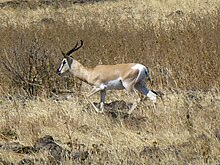 Summer ring gazelle ( Nanger soemmerringii )
Summer ring gazelle ( Nanger soemmerringii )
- Genus Gazella de Blainville , 1816
- Acacia Gazelle ( Gazella acaciae Mendelssohn, Groves & Shalmon , 1997)
- Indian gazelle or Dekkan chinkara ( Gazella bennettii ( Sykes , 1831))
- † Yemen gazelle ( Gazella bilkis Groves & Lay , 1985)
- Gujarat-Chinkara ( Gazella christii Blyth , 1842)
- Arabian desert gazelle ( Gazella cora ( CH Smith , 1827))
- Cuvier's gazelle ( Gazella cuvieri ( Ogilby , 1841))
- Farrur gazelle ( Gazella dareshurii Karami & Groves , 1993)
-
Dorcas gazelle ( Gazella dorcas ( Linnaeus , 1758))
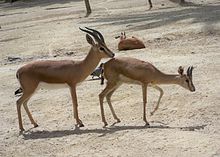 Dorcas Gazelle ( Gazella dorcas )
Dorcas Gazelle ( Gazella dorcas ) - Arabian coastal gazelle ( Gazella erlangeri Neumann , 1906)
- Baluchistan Chinkara ( Gazella fuscifrons Blanford , 1873)
- Real gazelle or Edmigazelle ( Gazella gazella ( Pallas , 1766))
- Turkmenistan goiter gazelle ( Gazella gracilicornis Stroganov , 1956)
- Bushir gazelle ( Gazella karamii Groves , 1993)
- Dune Gazelle ( Gazella leptoceros ( Cuvier , 1842))
- Sand gazelle ( Gazella marica Thomas , 1897)
- Muscat gazelle ( Gazella muscatensis Brooke , 1874)
- Pelzeln-Gazelle ( Gazella pelzelni Kohl , 1886)
- Punjab Chinkara or Rajasthan Gazelle ( Gazella salinarum Groves , 2003)
- † Saudi gazelle ( Gazella saudiya Carruthers & Schwarz , 1935)
- Iran chinkara or Shikari gazelle ( Gazella shikarii Groves , 1993)
-
Spekegazelle ( Gazella spekei Blyth , 1873)
 Spekegazelle ( Gazella spekei )
Spekegazelle ( Gazella spekei ) - Goiter gazelle ( Gazella subgutturosa ( Güldenstädt , 1780))
- Jarkand goiter gazelle ( Gazella yarkandensis Blanford , 1875)
- Genera Eudorcas Fitzinger , 1869
- Mongalla gazelle ( Eudorcas albonotata ( Rothschild , 1903))
- Western Thomson's gazelle ( Eudorcas nasalis ( Lönnberg , 1908))
- Red- fronted Gazelle ( Eudorcas rufifrons ( Gray , 1846))
- † Algerian gazelle ( Eudorcas rufina ( Thomas , 1894))
- Eastern Thomson's gazelle or Thomson's gazelle ( Eudorcas thomsonii ( Günther , 1884))
- Heuglin's gazelle ( Eudorcas tilonura ( Heuglin , 1869))
- Genus Dorcatragus Noack , 1894
- Beira ( Dorcatragus megalotis ( Menges , 1894))
- Genus Dikdiks ( Madoqua Ogilby , 1837)
- Cavendish-Dikdik ( Madoqua cavendishi Thomas , 1898)
-
Damara-Dikdik ( Madoqua damarensis ( Günther , 1880))Damara Dikdik ( Madoqua damarensis )
- Günther-Dikdik ( Madoqua guentheri Thomas , 1894)
- Harar-Dikdik or Rotbauchdikdik ( Madoqua hararensis Neumann , 1904)
- Hinde-Dikdik ( Madoqua hindei Thomas , 1902)
- Kirk-Dikdik ( Madoqua kirkii ( Günther , 1880))
- Lawrance-Dikdik ( Madoqua lawrancei Deake-Brockmann , 1926)
- Red-bellied Dikdik ( Madoqua phillipsi Thomas , 1894)
- Silberdikdik ( Madoqua piacentinii Drake-Brockmann , 1911)
- Eritrea Dikdik ( Madoqua saltiana ( Desmarest , 1817))
- Smith-Dikdik ( Madoqua smithii Thomas , 1901)
- Kleindikdik ( Madoqua swaynei Thomas , 1894)
- Thomas-Dikdik ( Madoqua thomasi ( Neumann , 1905))
- Genus Oribis ( Ourebia Laurillard , 1842)
- Serengeti-Oribi ( Ourebia hastata ( Peters , 1852))
-
Sudan Oribi ( Ourebia montana ( Cretzschmar , 1826))
 Sudan Oribi ( Ourebia montana )
Sudan Oribi ( Ourebia montana ) - Southern oribi, or bleaching ram ( Ourebia ourebi ( Zimmermann , 1783))
- Senegal Oribi ( Ourebia quadriscopa ( Hamilton Smith , 1827))
- Genus short-tailed gazelles ( Procapra Hodgson , 1846)
- Mongolian gazelle ( Procapra gutturosa ( Pallas , 1777))
- Tibetan Gazelle ( Procapra picticaudata Hodgson , 1846)
- Przewalski's gazelle ( Procapra przewalskii ( Büchner , 1891))
- Tribus Reduncini Knottnerus-Meyer , 1907
-
- Genus reedbucks ( Redunca C. H. Smith , 1827)
- Adamaoua reedbuck ( Redunca adamauae pepper , 1962)
- Great reedbuck ( Redunca arundinum ( Boddaert , 1785))
- Bohor reedbuck ( Redunca bohor Rüppell , 1842)
- East African mountain riedbuck ( Redunca chanleri ( Rothschild , 1895))
- Sudan reedbuck ( Redunca cottoni ( Rothschild , 1902))
-
Mountain Riedbuck or Southern Mountain Riedbuck ( Redunca fulvorufula ( Afzelius , 1815))
 Mountain Riedbuck ( Redunca fulvorufula )
Mountain Riedbuck ( Redunca fulvorufula ) - Chad Reedbuck ( Redunca nigeriensis ( Blaine , 1913))
- Zambian reedbuck ( Redunca occidentalis ( Rothschild , 1907))
- Common Reedbuck or Senegal Reedbuck ( Redunca redunca ( Pallas , 1767))
- Genus waterbuck ( Kobus A. Smith , 1840)
- Upemba litchi ( Kobus anselli Cotterill , 2005)
- Defassa waterbuck ( Kobus defassa ( Rüppell , 1835))
- Elliptical waterbuck ( Kobus ellipsiprymnus ( Ogilby , 1833))
- Kafue litchi ( Kobus kafuensis Haltorth , 1963)
- Senegal antelope or Kob ( Kobus kob ( Erxleben , 1777))
-
Lechwe or Lychee Moor Antelope ( Kobus leche Gray , 1850)
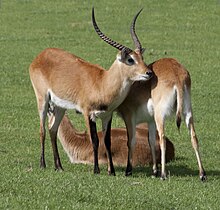 Letschwe ( Kobus leche )
Letschwe ( Kobus leche ) - White-eared bog antelope ( Kobus leucotis ( Lichtenstein & Peters , 1854))
- Cameroon grass antelope ( Kobus loderi ( Lydekker , 1900))
- White-naped bog antelope ( Kobus megaceros ( Fitzinger , 1855))
- † Roberts waterbuck ( Kobus robertsi ( Rothschild , 1907))
- Bangweulu litchi ( Kobus smithemani ( Lydekker , 1900))
- Uganda grass antelope ( Kobus thomasi ( Sclater , 1895))
- Puku ( Kobus vardonii ( Livingstone , 1857))
- Genus Pelea Gray , 1851
- Roe deer antelope ( Pelea capreolus ( Forster , 1790))
- Tribus Hippotragini Sundevall in Retzius & Lovén, 1845 ( rams )
-
- Genus horse antelopes or horse rams ( Hippotragus sundevall , 1845)
-
Roan antelope ( Hippotragus equinus ( Geoffroy Saint-Hilaire , 1803))
 Roan antelope ( Hippotragus equinus )
Roan antelope ( Hippotragus equinus ) - † Bluebuck ( Hippotragus leucophaeus ( Pallas , 1766))
- Sable antelope ( Hippotragus niger ( Harris , 1838); in some cases the East African sable antelope ( H. n. Roosevelti ) and the giant sable antelope ( H. n. Variani ) are separate species)
-
Roan antelope ( Hippotragus equinus ( Geoffroy Saint-Hilaire , 1803))
- Genus Addax Laurillard , 1842
- Mendes antelope or Addax ( Addax nasomaculatus ( de Blainville , 1816))
- Genus oryx antelopes ( Oryx de Blainville , 1810)
- Beisa oryx ( Oryx beisa ( Rüppell , 1835))
- Tuft-eared oryx ( Oryx callotis Thomas , 1892)
- Saber antelope ( Oryx dammah ( Cretzschmar , 1826))
- Galla oryx ( Oryx gallarum Neumann , 1902)
-
Gourmets or southern oryx ( Oryx gazella ( Linnaeus , 1758))
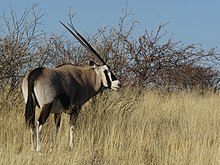 Gauntlet ( oryx gazella )
Gauntlet ( oryx gazella ) - Arabian oryx or white oryx ( Oryx leucoryx ( Pallas , 1777))
- Tribus Alcelaphini Brooke in Wallace, 1876 ( hartebeest )
-
- Genus red hartebeest ( Alcelaphus de Blainville , 1816)
- † North African hartebeest ( Alcelaphus buselaphus ( Pallas , 1766))
- Southern hartebeest or kaama hartebeest ( Alcelaphus caama ( Geoffroy Saint-Hilaire , 1803))
- Kongoni hartebeest or Cokes hartebeest ( Alcelaphus cokii Günther , 1884)
- Lelwel hartebeest ( Alcelaphus lelwel ( Heuglin , 1877))
- Lichtenstein antelope ( Alcelaphus lichtensteinii ( Peters , 1852))
- West African hartebeest ( Alcelaphus major ( Blyth , 1869))
- Somalia hartebeest ( Alcelaphus swaynei ( Sclater , 1892))
- Torah hartebeest ( Alcelaphus tora Gray , 1873)
- Genus Beatragus Heller , 1912
- Hunter antelope or Hirola ( Beatragus hunteri ( Sclater , 1889))
- Genus lyre antelope ( Damaliscus Sclater & Thomas , 1894)
- Ruaha topi ( Damaliscus eurus Blaine , 1914)
- Corrigum ( Damaliscus correctum ( Ogilby , 1834))
- Serengeti topi ( Damaliscus jimela ( Matschie , 1892))
- Sassaby ( Damaliscus lunatus ( Burchell , 1824))
- Blessbock ( Damaliscus phillipsi Harper , 1939)
-
Buntbock ( Damaliscus pygargus ( Pallas , 1767))
 Buntbock ( Damaliscus pygargus )
Buntbock ( Damaliscus pygargus ) - Bangweulu-Sassaby ( Damaliscus superstes Cotterill , 2003)
- Tiang ( Damaliscus tiang ( Heuglin , 1863))
- Coastal topi ( Damaliscus topi Blaine , 1914)
- Topi or Uganda topi ( Damaliscus ugandae Blaine , 1914)
- Genus Gnus ( Connochaetes Lichtenstein , 1812)
- White-bearded wildebeest or Eastern white-bearded wildebeest ( Connochaetes albojubatus Thomas , 1892)
- White-tailed wildebeest ( Connochaetes gnou ( Zimmermann , 1780))
- White -banded Gnu or Nyassa Gnu ( Connochaetes johnstoni Sclater , 1896)
- Serengeti white-bearded wildebeest or western white -bearded wildebeest ( Connochaetes mearnsi Heller , 1913)
-
Streifengnu ( connochaetes taurinus ( Burchell , 1824))
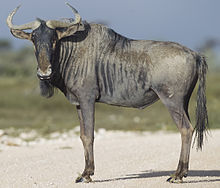 Streifengnu ( Connochaetes taurinus )
Streifengnu ( Connochaetes taurinus )
- Tribus Caprini Gray , 1821 ( goat-like )
-
- Genus Pantholops Hodgson , 1834
- Tschiru ( Pantholops hodgsoni ( Abel , 1826))
- Genus Oreamnos Rafinesque , 1817
- Mountain goat ( Oreamnos americanus ( de Blainville , 1816))
- Genus Takine ( Budorcas Hodgson , 1850)
- Goldtakin ( Budorcas benfordi Thomas , 1911)
- Mishmi takin ( Budorcas taxicolor Hodgson , 1850)
- Sichuan takin ( Budorcas tibetana Milne-Edwards , 1874)
- Bhutan takin ( Budorcas whitei Lydekker , 1907)
- Genus Ammotragus Blyth , 1840
-
Great barbary sheep ( Ammotragus lervia ( Pallas , 1777))
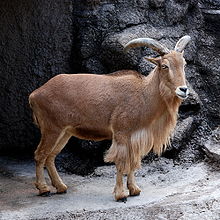 Barbary sheep ( Ammotragus lervia )
Barbary sheep ( Ammotragus lervia )
-
Great barbary sheep ( Ammotragus lervia ( Pallas , 1777))
- Genus Arabitragus Ropiquet & Hassanin , 2005
- Arabian tahr ( Arabitragus jayakiri ( Thomas , 1894))
- Genus Hemitragus Hodgson , 1841
- Himalayan tahr ( Hemitragus jemlahicus ( CH Smith , 1826))
- Genus Pseudois Hodgson , 1846
- Blue sheep ( Pseudois nayaur ( Hodgson , 1833))
- Dwarf blue sheep ( Pseudois schaeferi Haltorth , 1963)
- Genus goats ( Capra Linnaeus , 1758)
- Wild goat or bezoar goat ( Capra aegagrus Erxleben , 1777); the domestic goat was domesticated from this species
- West Caucasian Ibex or Kuban-Tur ( Capra caucasica Güldenstedt & Pallas , 1783)
- East Caucasian Ibex or Dagestan-Tur ( Capra cylindricornis ( Blyth , 1841))
- Screw goat or markhor ( Capra falconeri ( Wagner , 1839))
- Alpine ibex ( Capra ibex Linnaeus , 1758)
- Nubian Ibex or Syrian Ibex ( Capra nubiana F. Cuvier , 1825)
- Iberian ibex ( Capra pyrenaica Schinz , 1838)
- Siberian ibex ( Capra sibirica ( Pallas , 1776))
- Ethiopian ibex ( Capra walie Rüppell , 1835)
- Genus Nilgiritragus Ropiquet & Hassanin , 2005
- Nilgiri-Tahr ( Nilgiritragus hylocrius ( Ogilby , 1838))
- Genus sheep ( Ovis Linnaeus , 1758)
- Altai wild sheep ( Ovis ammon ( Linnaeus , 1758))
- Oman wild sheep ( Ovis arabica Sopin & Harrison , 1986)
- Tajikistan wild sheep ( Ovis bochariensis Nasonov , 1914)
-
Bighorn sheep ( Ovis canadensis Shaw , 1804)
 Bighorn sheep ( Ovis canadensis )
Bighorn sheep ( Ovis canadensis ) - Kazakhstan wild sheep ( Ovis collium Severtzov , 1873)
- Afghan Urial Sheep or Turkmenistan Wild Sheep ( Ovis cycloceros Hutton , 1842)
- Dall Sheep ( Ovis dalli Nelson , 1884)
- Gobi wild sheep ( Ovis darwini Przewalski , 1883)
-
Armenian wild sheep ( Ovis gmelini Blyth , 1841); of this kind was likely Hausschaf domesticated, possibly walked out of her the mouflon out
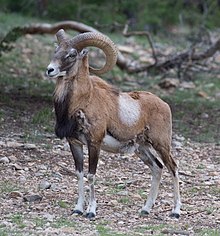 Armenian wild sheep ( Ovis gmelini )
Armenian wild sheep ( Ovis gmelini ) - Tibet Argali ( Ovis hodgsoni Blyth , 1841)
- Isphahan wild sheep ( Ovis isphahani Nasonov , 1910)
- North China Wild Sheep ( Ovis jubata Peters , 1876)
- Tienshan-Argali ( Ovis karelini Severtzov , 1873)
- Laristan wild sheep ( Ovis laristanica Nasonov , 1909)
- Karatau wild sheep ( Ovis nigrimontana Severtzov , 1873)
- Snow Sheep ( Ovis nivicola Eschscholtz , 1829)
- Pamir Argali ( Ovis polii Blyth , 1841)
- Punjab wild sheep ( Ovis punjabiensis Lydekker , 1913)
- Kyzylkum wild sheep ( Ovis severtzovi Nasonov , 1914)
- Ladakh wild sheep ( Ovis vignei Blyth , 1841)
- Genus chamois ( Rupicapra de Blainville , 1816)
- Anatolian chamois or Asia Minor chamois ( Rupicapra asiatica Lydekker , 1908)
- Carpathian chamois ( Rupicapra carpatica Couturier , 1938)
-
Abruzzo chamois ( Rupicapra ornata Neumann , 1899)Abruzzo chamois ( Rupicapra ornata )
- Cantabrian chamois ( Rupicapra parva Cabrera , 1911)
- Pyrenean chamois ( Rupicapra pyrenaica Bonaparte , 1845)
- Chamois or Alpine chamois ( Rupicapra rupicapra ( Linnaeus , 1758))
- Genus Myotragus Bate , 1909
- † Cave goat ( Myotragus balearicus Bate , 1909)
- Genus Gorale ( Naemorhedus C. H. Smith , 1827)
- Red goral or Tibetan goral ( Naemorhedus baileyi Pocock , 1914)
- West Himalayan goral ( Naemorhedus bedfordi ( Lydekker , 1905))
- Long-tailed goral or North China goral ( Naemorhedus caudatus ( Milne-Edwards , 1876))
- Burma goral ( Naemorhedus evansi ( Lydekker , 1905))
-
Gray goral or East Himalayan goral ( Naemorhedus goral ( Hardwicke , 1825))
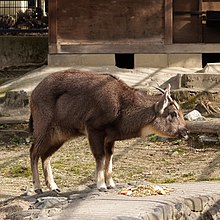 Gray goral ( Naemorhedus goral )
Gray goral ( Naemorhedus goral ) - Chinese goral or West China goral ( Naemorhedus griseus ( Milne-Edwards , 1871))
- Genus Seraue ( Capricornis ogilby , 1837)
- Japanese serau ( Capricornis crispus ( Temminck , 1844))
- Indochinese serau ( Capricornis maritimus Heude , 1888)
- Chinese serau ( Capricornis milneedwardsii David , 1869)
- Red serau ( Capricornis rubidus Blyth , 1863)
- Southern Serau or Sumatra Serau ( Capricornis sumatraensis ( Bechstein , 1799))
- Taiwan Serau or Fomosa Serau ( Capricornis swinhoei Gray , 1862)
- Himalaya Serau or Nepal Serau ( Capricornis thar ( Hodgson , 1831))
- Genus Ovibos de Blainville , 1816
- Tribus Cephalophini Blyth , 1863 ( Ducker )
-
- Genus Sylvicapra Ogilby , 1837
- Senegalese duiker ( Sylvicapra coronata ( Gray , 1842))
- Crown duiker ( Sylvicapra grimmia ( Linnaeus , 1758))
- Sahel crown duiker ( Sylvicapra pallidor Schwarz , 1914)
- Genus Philantomba Blyth , 1840
- East Africa blue duiker ( Philantomba aequatorialis ( Matschie , 1892))
- Angola blue duiker ( Philantomba anchietae ( Bocage , 1879))
- Zimbabwean blue duiker ( Philantomba bicolor ( Gray , 1863))
- Congo blue duiker ( Philantomba congica ( Lönnberg , 1908))
- Malawi blue duiker ( Philantomba hecki ( Matschie , 1897))
- Zambia blue duiker ( Philantomba defriesi ( Rothschild , 1904))
- Tanzanian blue duiker ( Philantomba lugens ( Thomas , 1898))
- Maxwell duiker ( Philantomba maxwelli ( CH Smith , 1827))
- Bioko blue duiker ( Philantomba melanorhea ( Gray , 1846))
-
Blue duiker or Cape blue duiker ( Philantomba monticola ( Thunberg , 1789))
 Blue duiker ( Philantomba monticola )
Blue duiker ( Philantomba monticola ) - Simpson's blue duiker ( Philantomba simpsoni ( Thomas , 1910))
- Verheyen-Ducker ( Philantomba walteri Colyn, Hulselmans, Sonet, Oudé, De Winter, Natta, Nagy & Verheyen , 2010)
- Genus Cephalophus C. H. Smith , 1827
- Zanzibar duiker ( Cephalophus adersi Thomas , 1918)
- Uëlle white-bellied duiker ( Cephalophus arrheni Lönnberg , 1917)
- Brooke duiker ( Cephalophus brookei Thomas , 1903)
- Petersducker ( Cephalophus callipygus Peters , 1876)
- Congo black- backed duiker ( Cephalophus castaneus Thomas , 1892)
- White-legged thickener ( Cephalophus crusalbum Grubb , 1978)
- Eastern yellow-bridged duiker ( Cephalophus curticeps Grubb & Groves , 2001)
-
Black- backed duiker ( Cephalophus dorsalis gray , 1846)Black- backed duiker ( Cephalophus dorsalis )
- Elgon black- fronted duiker ( Cephalophus forsteri St. Leger , 1934)
- Harvey's red duiker ( Cephalophus harveyi ( Thomas , 1893))
- Kenyan black- forehead duiker ( Cephalophus hooki St. Leger , 1934)
- Itombwe black- fronted duiker ( Cephalophus hypoxanthus Grubb & Groves , 2001)
- Jentink duiker ( Cephalophus jentinki Thomas , 1892)
- Johnston Ducker ( Cephalophus johnstoni Thomas , 1901)
- Lestrade duiker ( Cephalophus lestradei Grubb & Groves , 1974)
- White-bellied duiker ( Cephalophus leucogaster Gray , 1873)
- Natal red duiker or red duiker ( Cephalophus natalensis A. Smith , 1834)
- Black duiker ( Cephalophus niger gray , 1846)
- Black- fronted Thucker ( Cephalophus nigrifrons Gray , 1871)
- Ogilby Ducker or Fernando Po Ducker ( Cephalophus ogilbyi ( Waterhouse , 1838))
- Ruwenzori black- forehead duiker or Ruwenzoriducker ( Cephalophus rubidus Thomas , 1901)
- Red-flanked duiker ( Cephalophus rufilatus Gray , 1846)
-
Yellow-bridged duiker ( Cephalophus silvicultor ( Afzelius , 1815))
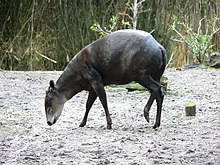 Yellow-bridge duiker ( Cephalophus silvicultor )
Yellow-bridge duiker ( Cephalophus silvicultor ) - Abbott duiker ( Cephalophus spadix true , 1890)
- Weyns duiker ( Cephalophus weynsi Thomas , 1901)
- Zebra sugar ( Cephalophus zebra ( Gray , 1838))
- Tribus Oreotragini Pocock , 1910
-
- Klipspringer genus ( Oreotragus A. Smith , 1834)
- Tanzanian Klipspringer ( Oreotragus aceratos Noack , 1899)
- Kenya Klipspringer ( Oreotragus aureus Heller , 1913)
- Zambia klipspringer ( Oreotragus centralis Hinton , 1921)
- Cape Klipspringer or Klipspringer ( Oreotragus oreotragus ( Zimmermann , 1783))
- Nigeria Klipspringer ( Oreotragus porteousi Lydekker , 1911)
- Ethiopia klipspringer ( Oreotragus saltatrixoides ( Temminck , 1853))
- Maasai Klipspringer or Schillings Klipspringer ( Oreotragus schillingsi Neumann , 1902)
- Somali klipspringer ( Oreotragus somalicus Neumann , 1902)
- Zimbabwean Klipspringer ( Oreotragus stevensoni Roberts , 1946)
- Angola Klipspringer ( Oreotragus tyleri Hinton , 1921)
-
Transvaal klipspringer ( Oreotragus transvaalensis Roberts , 1917)Transvaal Klipspringer ( Oreotragus transvaalensis )
-
In most of the newer classifications since 2004, bison is listed within Bos , since the American bison forms a common group with the yak, while the bison, on the other hand, with the domestic cattle (or the aurochs). According to molecular genetic studies, the eland antelopes ( Taurotragus ) are embedded in the genus Tragelaphus in their original definition, for this reason the latter have been split into up to five genera. The goats were traditionally united in the genus Neotragus . According to studies from 2014, however, this is polyphyletic and only contains the small ram ( Neotragus pygmaeus ). All other species are now placed in the genus Nesotragus . The investigations also showed that Nesotragus is more closely related to the Impalas ( Aepyceros ) (as originally thought for all goats), both together form the sister group of all other Antilopinae. Neotragus, on the other hand, is closely related to the duckers (Cephalophini) and the cliff jumpers ( Oreotragus ). It must be worked out in further investigations whether Nesotragus can be combined with the Aepycerotini and Neotragus with the Cephalophini or with the Oreotragini. Within the duiker themselves, Cephalophus is not monophyletic , since the genus also includes Sylvicapra . May need Cephalophus are therefore split, have been proposed as Cephalophorus to resume there at the Peter and the red duiker and black-fronted duiker and Ogilby-Ducker, and Leucocephalophus for the Zanzibar duiker.
The antelopes do not form a uniform taxon within the horn-bearers; the term "antelope" is just a collective term for slim, tropical hornbeams that has nothing to do with the relationships. The name goes back to the Greek word ανθὀλωπς ( antholops "flower eye ") and referred to a mythical monster. The word gazelle, which is derived from the Arabic ghazal, has a similar meaning .
Conservatism or Inflation - On the Biodiversity of the Hornbeams
Up until the beginning of the 21st century, around 140 species were differentiated into 45 genera, a revision published in 2011 by Colin Peter Groves and Peter Grubb revealed around 280 species spread over almost 55 genera. The high increase, which almost doubled the number of members in the family, was mainly due to the splitting up of the existing species, and less due to new discoveries, whereby numerous former subspecies were shifted to species status. Groves and Grubb partly followed the phylogenetic species concept . After the publication, their approach was heavily criticized by some scientists as “taxonomic inflation”. The criticism referred, among other things, to the inconsistent species concept of biology, which enabled Groves and Grubb to separate individual groups and populations from the metapopulations considered as species and to reduce them to partially spatially narrow, endemic species. Furthermore, the possible negative impact on species protection that could result from the split was criticized, as a higher number of species require more resources to preserve them. In addition, this could make it more difficult, for example, to relocate severely threatened individual groups, who would then be exposed to the risk of hybridization . For example, some researchers found the extreme splitting of the seraue into six and the klipspringer into eleven species as excessive and morphologically unsustainable. On the other hand, proponents believe that many species that have only recently been identified by genetic analysis can often not be separated by purely external characteristics. Such swarms of species or “cryptic species” occur repeatedly not only in small, but also in large mammals. During the mid-1990s, when the horn carriers Kirk's Dik within the gazelle-like could be identified as species flock, in the first decade of the 21st century were among others, the bushbuck -Artkomplex within the Tragelaphini , the tsessebe -Artkomplex within the hartebeest , the lychee -Artkomplex within the waterbuck , the Grant's gazelles -Artkomplex within the gazelle-like and the Maxwell's duiker -Artkomplex within the Ducker has more. Genetic studies have also shown that the Tahre (originally Hemitragus ) are actually polyphyletic and contain several species and genera. In principle, the actual number of species within the horned species would be greatly underestimated due to cryptic species, and the revision carried out is therefore considered long overdue. In the case of the klipspringer, the individual populations are distributed discontinuously across eastern and southwestern Africa and, due to their specialization in rocky regions, only present in individual landscape islands. As a result, they represent habitat specialists, comparable to some goat forms, whose individual, separate populations have their own biogeographical history. In the opinion of those in favor of splitting up, species protection could well benefit from the uncovering of these cryptic species, as species would then come more into the spotlight, which are otherwise mostly overlooked by the conservative taxonomy in the corresponding swarm of species.
Tribal history
While the even- toed ungulates are a relatively old group in terms of their phylogeny and with Diacodexis can already be detected in the Lower Eocene around 55 million years ago, the hornbearers appeared relatively late in geological terms. Forerunners of today's bovids were already present with Palaeohypsodontus in the Upper Oligocene in Asia and with Andegameryx or Hispanomeryx in the Lower Miocene in Europe. These early forms are mostly hornless animals with slightly high-crowned teeth, which already reveal the selenodontic chewing surface pattern. The genus Eotragus from the Lower Miocene is one of the oldest known representatives of true bovids . These animals resembled today's duiker antelopes , were never larger than deer and had very small, spear-like horns that were very close together. Very early finds, which date back to around 18 million years ago, come from Western Europe and Central Asia; some horn fragments have also been found in Southeast Asia for the Middle Miocene. Eotragus is usually regarded as a stem bovine, Pseudoeotragus from Central Europe is only slightly younger and possibly belongs to the ancestral line of the antilopins. Even during the Miocene there was a strong diversification within the horn carriers in Europe, Asia and Africa, at the latest in the Pliocene all important lines of the horn carriers were already represented. Some developed exclusively in Africa, such as the tragelaphini, but most were relatively widespread across Eurasia and Africa. The relocation of horn-bearers to North America has so far been little studied. The first representatives there are from the Upper Miocene around 7.5 to 6.8 million years ago and are represented by Neotragocerus with an imprecise relationship. In the Lower Pliocene almost 5 million years ago, Sinocapra , a close relative of the sheep in southwestern North America , appeared for the first time.
Research history
The history of research and systematic classification of the hornbeams goes back to the first half of the 19th century. Linnaeus had previously introduced the genera Capra , Ovis and Bos in his work Systema naturae , which represent the core group of today's horn-bearers. He classified these together with Camelus , Musk and Cervus within the Pecora . Further genera of the hornbeams followed relatively shortly after Linnaeus, for example Antilope by Peter Simon Pallas in 1766. In the late 18th and early 19th centuries, the representatives of today's artifacts were settled in relatively different groups, Johann Friedrich Blumenbach, for example, referred in his 1779 Handbook of Natural History the cattle, sheep, goats, gazelles, deer, camels and pigs to the "Bisulca" (animals with forked claws). John Edward Gray introduced the family name Bovidae, which is valid today for the horned bearers, in 1821. He also put the Capridae with the sheep and goats as well as the Antilopidae aside and classified all of them together with the Moschidae (musk deer) , the Cervidae (deer) and the Giraffidae (giraffes) in the group of Ruminantia (ruminants). In his catalog of the British Museum from 1873, Gray distinguished 16 families, including the Antilocapridae (fork-horned animals), which were closely related to the group, which includes the cattle, sheep, goats and antelopes were considered related to the horn bearers. Only later authors then summarized all forms under the term Bovidae in the transition from the 19th to the 20th century, but there was uncertainty about the exact internal structure of the family. Mostly 10 to 15 taxonomic units were recognized, which were usually run as a subfamily, but sometimes also as tribes.
At the beginning of the 20th century, Max Schlosser first recognized the division of horns into two parts and differentiated them in the structure of the molars, separating the boodontia from the aegodontia. Boodonte teeth (comparable to the "Mahlern") are characterized by a very large chewing surface and prominent ridges on the outer and inner side edges as well as by a complex contour of the central recess, while aegodonte teeth (roughly corresponding to the "tailors") are smaller, have flatter sidewalls and a less complex recess. Due to the division of the hornbeams, Schlosser led the lower taxa on the level of the Triben (but gave them the names of subfamilies). In his classic classification of mammals from 1945, George Gaylord did not fully follow Simpson Schlosser. He divided the Bovidae into five subfamilies, the non-bovine forms included with him four groups with the Cephalophinae, the Hippotraginae, the Antilopinae and the Caprinae, and assigned a total of 13 tribes to these. Another attempt at a systematic was made by Alan W. Gentry in 1992 who, like Simpson, differentiated five subfamilies and 13 tribes, which, however, had a different arrangement. After a cladistic analysis of skeletal features, he came to the conclusion that duiker and cattle, despite their great differences, are closely related and should be grouped together in a common subfamily, the bovinae. The impalas were assigned to the hartebeest, the roe deer and the saiga to the gazelle-like. In their work Mammal Species of the World , Don E. Wilson and DeeAnn M. Reeder again distinguished eight subfamilies in 2005 without going into specific tribes.
All previous attempts at structuring were based on skeletal anatomical features. With the advent of molecular genetic analysis methods at the end of the 20th century, it was possible to better resolve the division of the hornbeams, which Schlosser had already noticed. So two clades could be distinguished, the Bovinae and the Antilopinae, which occupy the rank of subfamilies. The Antilopinae include all non-bovine forms of the previous, anatomically and morphologically justified attempts at classification.
literature
- Richard D. Estes: Social organization of the African Bovidae. In: V. Geist and F. Walther (eds.): The Behavior of Ungulates and its relation to management. IUCN, Morges, 1974, pp. 166-205
- Colin P. Groves and Peter Grubb: Ungulate Taxonomy. Johns Hopkins University Press, 2011, pp. 1-317 (pp. 108-280)
- Colin P. Groves and David M. Leslie Jr .: Family Bovidae (Hollow-horned Ruminants). In: Don E. Wilson and Russell A. Mittermeier (eds.): Handbook of the Mammals of the World. Volume 2: Hooved Mammals. Lynx Edicions, Barcelona 2011, ISBN 978-84-96553-77-4 , pp. 444-779
- PJ Jarman: The Social Organization of Antelope in Relation to Their Ecology. Behavior 48 (3/4), 1974, pp. 215-267
- Don E. Wilson and DM Reeder: Mammal Species of the World . Johns Hopkins University Press, Baltimore 2005, ISBN 0-8018-8221-4
Individual evidence
- ↑ a b c Meike Köhler: Skeleton and habitat of recent and fossil ruminants. Münchner Geoscientific Abhandlungen A 25, 1993, pp. 1–88
- ↑ a b c d e f g h i j k Colin P. Groves and David M. Leslie Jr .: Family Bovidae (Hollow-horned Ruminants). In: Don E. Wilson and Russell A. Mittermeier (eds.): Handbook of the Mammals of the World. Volume 2: Hooved Mammals. Lynx Edicions, Barcelona 2011, ISBN 978-84-96553-77-4 , pp. 444-779
- ^ Theodore Stankowich and Tim Caro: Evolution of weaponry in female bovids. Proceedings of the Royal Society B 276, 2009, pp. 4329-4334
- ↑ Nikos Solounias: Family Bovidae. In: Donald R. Prothero and Scott E. Foss (Eds.): The Evolution of Artiodactyls. Johns Hopkins University, Baltimore, 2007, pp. 278-291
- ↑ a b c Alan W. Gentry: Bovidae. In: Lars Werdelin and William Joseph Sanders (eds.): Cenozoic Mammals of Africa. University of California Press, Berkeley, Los Angeles, London, 2010, pp. 741-796
- ↑ a b c Jonathan Kingdon, David Happold, Michael Hoffmann, Thomas Butynski, Meredith Happold and Jan Kalina (eds.): Mammals of Africa Volume VI. Pigs, Hippopotamuses, Chevrotain, Giraffes, Deer and Bovids. Bloomsbury, London 2013, pp. 120-606
- ↑ Andrew A. Farke, Evolution and functional morphology of the frontal sinuses in Bovidae (Mammalia: Artiodactyla), and implications for the evolution of cranial pneumaticity. Zoological Journal of the Linnean Society 159, 2010, pp. 988-1014
- ^ William J. Silvia, Charles H. Hamilton and William F. Silvia: The occurrence of metatarsal splint bones in ruminants and their potential use in establishing phylogenetic relationships. Zitteliana B 32, 2014, pp. 155-162
- ↑ a b P. J. Jarman: The Social Organization of Antelope in Relation to Their Ecology. Behavior 48 (3/4), 1974, pp. 215-267
- ^ Richard D. Estes: Social organization of the African Bovidae. In: V. Geist and F. Walther (eds.): The Behavior of Ungulates and its relation to management. IUCN, Morges, 1974, pp. 166-205
- ↑ a b c d e Juan P. Zurano, Felipe M. Magalhães, Ana E. Asato, Gabriel Silva, Claudio J. Bidau, Daniel O. Mesquita and Gabriel C. Costa: Cetartiodactyla: Updating a time-calibrated molecular phylogeny. Molecular Phylogenetics and Evolution 133, 2019, pp. 256-262
- ↑ Edward Byrd Davis: Family Antilocapridae. In: Donald R. Prothero and Scott E. Foss (Eds.): The Evolution of Artiodactyls. Johns Hopkins University, Baltimore, 2007, pp. 227-240
- ^ A b Jonathan D. Marcot: Molecular Phylogeny of terrestrial artioidactyls. In: Donald R. Prothero and Scott E. Foss (Eds.): The Evolution of Artiodactyls. Johns Hopkins University, Baltimore 2007, pp. 4-18
- ↑ Michelle Spaulding, Maureen A. O'Leary, and John Gatesy: Relationships of Cetacea (Artiodactyla) Among Mammals: Increased Taxon Sampling Alter Interpretations of Key Fossils and Character Evolution. PlosOne 4 (9), 2009, p. E7062
- ↑ a b c d e Alexandre Hassanin, Frédéric Delsuc, Anne Ropiquet, Catrin Hammer, Bettine Jansen van Vuuren, Conrad Matthee, Manuel Ruiz-Garcia, François Catzeflis, Veronika Areskoug, Trung Thanh Nguyen and Arnaud Couloux: Pattern and timing of diversification of Cetartiodactyla (Mammalia, Laurasiatheria), as revealed by a comprehensive analysis of mitochondrial genomes. Comptes Rendus Palevol 335, 2012, pp. 32-50
- ↑ a b c d Fayasal Bibi: A multi-calibrated mitochondrial phylogeny of extant Bovidae (Artiodactyla, Ruminantia) and the importance of the fossil record to systematics. BMC Evolutionary Biology 13, 2013, p. 166
- ^ A b c George Gaylord Simpson: The Principles of Classification and a Classification of Mammals. Bulletin of the American Museum of Natural History 85, 1945, pp. 1–350 (pp. 270–272)
- ^ A b Max Schlosser: Mammalia, mammal. In: Karl von Zittel: Basics of paleontology (paleozoology). Munich, Berlin, 1911, pp. 497-506
- ↑ a b c Alexandre Hassanin and Emmanuel JP Douzery: The Tribal Radiation of the Family Bovidae (Artiodactyla) and the Evolution of the Mitochondrial Cytochrome b Gene. Molecular Phylogenetics and Evolution 13 (2), 1999, pp. 227-243
- ^ A b Colin Groves and Peter Grubb: Ungulate Taxonomy. Johns Hopkins University Press, 2011, pp. 1-317 (pp. 108-280)
- ↑ Jose R. Castello: Bovids of the World. Princeton University Press, 2015, pp. 1-662
- ^ A b Eva V. Bärmann and Tim Schikora: The polyphyly of Neotragus - Results from genetic and morphometric analyzes. Mammalian Biology 79, 2014, pp. 283-286
- ↑ Alexandre Hassanin and Anne Ropiquet: Molecular phylogeny of the tribe Bovini (Bovidae, Bovinae) and the taxonomic status of the Kouprey, Bos sauveli Urbain 1937. Molecular Phylogenetics and Evolution 33, 2004, pp. 896-907
- ^ Anne R Johnston and Nicola M Anthony: A multi-locus species phylogeny of African forest duikers in the subfamily Cephalophinae: evidence for a recent radiation in the Pleistocene. BMC Evolutionary Biology, 12, 2012, p. 120 ( [1] )
- ^ Colin Groves: Current taxonomy and diversity of crown ruminants above the species level. Zitteliana B 32, 2014, pp. 5-14
- ↑ Rasmus Heller, Peter Frandsen, Eilene D. Lorenzen and Hans R. Siegismund: Are There Really Twice as Many Bovid Species as We Thought? Systematic Biology 62 (3), 2013, pp. 490-493
- Jump up ↑ Frank E. Zachos, Marco Apollonio, Eva V. Bärmann, Marco Festa-Bianchet, Ursula Göhlich, Jan Christian Habel, Elisabeth Haring, Luise Kruckenhauser, Sandro Lovari, Allan D. McDevitt, Cino Pertoldi, Gertrud E. Rössner, Marcelo R Sánchez-Villagra, Massimo Scandura and Franz Suchentrunk: Species inflation and taxonomic artefacts - A critical comment on recent trends in mammalian classification. Mammalian Biology 78, 2013, pp. 1-6
- ^ Frank E. Zachos: Commentary on taxonomic inflation, species delimitation and classification in Ruminantia. Zitteliana B 32, 2014, pp. 213-216
- ↑ Arlene T. Kumamoto, Steven C. Kingswood and Wouter Hugo: Chromosomal divergence in allopatric populations of Kirk's Dikdik, Madoqua kirki (Artiodactyla, Bovidae). Journal of Mammology 75 (2), 1994, pp. 357-364
- ↑ Yoshan Moodley, Michael W. Bruford, Christoph Bleidorn, Torsten Wronski, Ann Apio and Martin Plath: Analysis of mitochondrial DNA data reveals non-monophyly in the bushbuck (Tragelaphus scriptus) complex. Mammalian Biology 74, 2009, pp. 418-422
- ↑ Fenton PD Cotterill: Insights into the taxonomy of tsessebe antelopes Damaliscus lunatus (Bovidae: Alcelaphini) with the description of a new evolutionary species in south-central Africa. Durban Museum Novitates 28, 2003, pp. 11-30
- ^ Fenton PD Cotterill: The Upemba lechwe, Kobus anselli: an antelope new to science emphasizes the conservation importance of Katanga, Democratic Republic of Congo. Journal of Zoology 265, 2005, pp. 113-132
- ^ Eline D. Lorenzen, Peter Arctander and Hans R. Siegismund: Three reciprocally monophyletic mtDNA lineages elucidate the taxonomic status of Grant's gazelles. Conservation Genetics 9, 2008, pp. 593-601
- ↑ Marc Colyn, Jan Huselmans, Gontran Sonet, Pascal Oudé, Jan De Winter, Armand Natta, Zolatán Tamás Nagy and Erik Verheyen: Discovery of a new duiker species (Bovidae: Cephalophinae) from the Dahomey Gap, West Africa. Zootaxa 2637, 2010, pp. 1-30
- ^ Anne Ropiquet and Alexandre Hassanin: Molecular evidence for the polyphyly of the genus Hemitragus (Mammalia, Bovidae). Molecular Phylogenetics and Evolution 36, 2005, pp. 154-168
- ↑ Spartaco Gippoliti, Fenton PD Cotterill and Colin P. Groves: Mammal taxonomy without taxonomists: a reply to Zachos and Lovari. Hystrix, the Italian Journal of Mammalogy 24 (2), 2013, pp. 145-147
- ^ Fenton PD Cotterill, Peter J. Taylor, Spartaco Gippoliti, Jaqueline M. Bishop, and Colin P. Groves: Why One Century of Phenetics is Enough: Response to "Are There Really Twice As Many Bovid Species As We Thought?". Systematic Biology 63 (5), 2014, pp. 819-832
- ↑ Spartaco Gippoliti, Fenton PD Cotterill, Dietmar Zinner and Colin P. Groves: Impacts of taxonomic inertia for the conservation of African ungulate diversity: an overview. Biological Reviews, 2017 doi: 10.1111 / brv.12335
- ↑ Kenneth D. Rose: Skeleton of Diacodexis, Oldest Known Artiodactyl. Science 216, 1982, pp. 621-623
- ↑ John C. Barry, Susanne Cote, Laura MacLatchy, Everett H. Lindsay, Robert Kityo and A. Rahim Rajpar: Oligocene and Early Miocene Ruminants (Mammalia, Artiodactyla) from Pakistan and Uganda. Palaeontologia Electronica 8 (1), 2005, p. 22A ( PDF )
- ^ Israel M. Sánchez, M. Soledad Domingo and Jorge Morales: The genus Hispanomeryx (Mammalia, Ruminantia, Moschidae) and its bearing on musk deer phylogeny and systematics. Palaeontology 53 (5), 2010, pp. 1023-1047
- ↑ V. Quiralte and J. Morales: Andegameryx andegaviensis Ginsburg, 1971 (Artiodactyla, ruminant,) from the Early Miocene site of Estrepouy (MN3, France). Estudios Geológicos 67 (2), 2011, pp. 423-426
- ↑ Kantapon Suraprasit, Yaowalak Chaimanee, Olivier Chavasseau and Jean-Jaques Jaeger: Middle Miocene bovids from Mae Moh Basin, Northern Thailand: The first record of the genus Eotragus from Southeast Asia. Acta Palaeontologica Polonica 60 (1), 2015, pp. 67-78
- ↑ Jim I. Mead and Louis H. Taylor: New Species of Sinocapra (Bovidae, Caprinae) from the Lower Pliocene Panaca Formation, Nevada, USA. Palaeontologia Electronica 8 (1), 2005, p. 11A ( PDF )
- ↑ Fayasal Bibi, Maia Bukhsianidze, Alan W. Gentry, Denis Geraads, Dimitri S. Kostopoulos and Elisabeth S. Vrba: The Fossil Record and Evolution of Bovidae: State of the Field. Palaeontologia Electronica 12 (3), 2009, p. 10A ( PDF )
- ↑ Alan W. Gentry, Gertrud E. Rössner and Elmar PJ Heizmann: suborder ruminant. In: Gertrud E. Rössner and Kurt Heissig: The Miocene land mammals of Europe. Munich 1999, pp. 225-257
- ^ Johann Friedrich Blumenbach: Handbook of natural history. Göttingen 1779, pp. 1–448 (pp. 112–128)
- ↑ John Edward Gray: On the natural arrangement of vertebrose animals. London Medical Repository 15, 1821, pp. 297-310 (306-307)
- ^ John Edward Gray: Catalog of ruminant Mammalia (Pecora, Linnaeus), in the British Museum. London, British Museum (Natural History), 1872, pp. 1–102 ( [2] )
- ^ Alan W. Gentry: The subfamilies and tribes of the family Bovidae. Mammal Review 22 (1), 1992, pp. 1-32
- ↑ Don E. Wilson and DeeAnn M. Reeder: Mammal Species of the World . Johns Hopkins University Press, Baltimore, 2005 ISBN 0-8018-8221-4 ( [3] )

